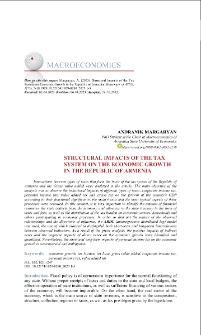Օբյեկտ
Վերնագիր: Structural Impacts of the Tax System on Economic Growth in the Republic of Armenia
Հրապարակման մանրամասներ:
Ամսագրի կամ հրապարակման վերնագիր:
Հրապարակման ամսաթիվ:
Համար:
ISSN:
Պաշտոնական URL:
Ծածկույթ:
Ամփոփում:
Interactions between types of taxes that form the basis of the tax system of the Republic of Armenia and the Gross value added were analyzed in the article. The main objective of the analysis was to observe the behavioral impacts of different types of taxes: corporate income tax, personal income tax, value added tax and excise tax on the growth of the country's GDP according to their functional significance, the main trends and the most typical aspects of these processes were revealed. In this context, it is very important to identify the amount of financial resources the state collects from the economy and allocates to the state treasury in the form of taxes and fees, as well as the distribution of the tax burden on economic sectors, households and others participating in economic processes. In order to find out the nature of the observed relationships and the directions of influence, the ARDL (autoregressive distributed lag) model was used, the use of which allowed to distinguish both short-term and long-term interrelations between observed indicators. As a result of the given analysis, the positive impacts of indirect taxes and the negative impacts of direct taxes on the economic growth were identified and quantified. Nevertheless, the short and long-term impacts of personal income tax on the economic growth is controversial and ambiguous.
Հրատարակության վայրը:
Երևան
Հրատարակիչ:
Ձևաչափ:
Ֆիզիկական այլ նկարագրություն:
Նույնացուցիչ:
oai:arar.sci.am:361629
Լեզու:
Գլխավոր նշում:
Նյութը վերցված է Հայաստանի պետական տնտեսագիտական համալսարանի կայքից։
Օբյեկտի հավաքածուներ:
Վերջին անգամ ձևափոխված:
Jan 31, 2025
Մեր գրադարանում է սկսած:
Aug 4, 2023
Օբյեկտի բովանդակության հարվածների քանակ:
53
Օբյեկտի բոլոր հասանելի տարբերակները:
https://arar.sci.am/publication/390955
Ցույց տուր նկարագրությունը RDF ձևաչափով:
Ցույց տուր նկարագրությունը OAI-PMH ձևաչափով։
-
Բանբեր Հայաստանի պետական տնտեսագիտական համալսարանի=Вестник Армянского государственного экономического университета=Messenger of Armenian State University of Economics
-
Բանբեր ՀՊՏՀ, 2011
-
Բանբեր ՀՊՏՀ, 2012
-
Բանբեր ՀՊՏՀ, 2013
-
Բանբեր ՀՊՏՀ, 2014
-
Բանբեր ՀՊՏՀ, 2015
-
Բանբեր ՀՊՏՀ, 2016
-
Բանբեր ՀՊՏՀ, 2017
-
Բանբեր ՀՊՏՀ, 2018
-
Բանբեր ՀՊՏՀ, 2019
-
Բանբեր ՀՊՏՀ, 2020
-
Բանբեր ՀՊՏՀ, 2021
-
Messenger of ASUE, 2022
-
Messenger of ASUE, 2023
-
Messenger of ASUE, 2023, 1
- Կազմ; Խմբագրական խորհուրդ
- Contents
- Structural Impacts of the Tax System on Economic Growth in the Republic of Armenia
- Embracing Finance 4.0: the Opportunity for Armenian Banks to Transform and Thrive
- The Behavioral Responses of the Employees and the Ways of Improvement While Facing Changes in the Organization
- Tourism Development Trends in the Republic of Armenia After COVID-19 Pandemic and in the Context of Russian-Ukrainian War
- Dynamic Interrelationships Between EAEU Foreign Trade and Macroeconomic Indicators: An Empirical Analysis
- The Chronology of Economic Instabilities of the EAEU Countries
- Analysis of the Globalization of Human Capital on the Example of the Republic of Armenia
- Philosophical Comprehension of the Psychological and Information Influence Technologies in the Modern World
-
Messenger of ASUE, 2023, 2
-
Messenger of ASUE, 2023, 3
-
Messenger of ASUE, 2023, 1
-
Messenger of ASUE, 2024
-
Messenger of ASUE, 2025
-
Բանբեր ՀՊՏՀ, 2011
| Հրատարակության անուն | Ամսաթիվ |
|---|---|
| Margaryan, Andranik, Structural Impacts of the Tax System on Economic Growth in the Republic of Armenia | Jan 31, 2025 |





